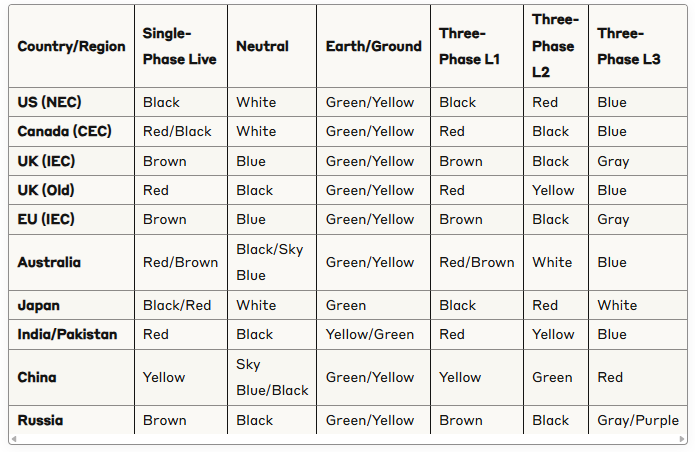What Are the Power Cable Conductor Colour Codes by Country?
Looking for the correct cable conductor colour codes used in different countries? This comprehensive guide breaks down international power cable color standards—including NEC, CEC, and IEC—for safe and compliant electrical wiring across regions like the US, EU, Australia, and Asia.
hongjing.Wang@Feichun
7/16/20257 min read
Why Do Cable Conductor Colour Codes Matter?
Electrical safety begins with proper identification, and nothing is more critical than understanding power cable conductor colour codes across different countries. These standardized color systems serve as the universal language of electrical professionals, preventing potentially fatal mistakes and ensuring compliance with local regulations.
Standardized color codes in power cable wiring act as the first line of defense against electrical accidents. When electricians and engineers can instantly identify live wires, neutral conductors, and protective earth connections through consistent color coding, the risk of electrocution, short circuits, and equipment damage drops significantly. This becomes even more crucial in international projects where teams from different countries must work together safely.
The role of cable colour codes extends beyond immediate safety concerns. They ensure regulatory compliance across jurisdictions, facilitate maintenance and troubleshooting, and enable seamless integration of electrical systems in multinational installations. Whether you're working on a residential project in Singapore or an industrial facility spanning multiple countries, understanding these codes is essential.
Global variations in cable conductor colour codes primarily stem from three major standards: the International Electrotechnical Commission (IEC) used across Europe, Asia, and other regions; the National Electrical Code (NEC) governing the United States; and the Canadian Electrical Code (CEC). These standards have evolved differently due to historical, technical, and regulatory factors, creating a complex landscape that electrical professionals must navigate.
The transition from legacy systems to modern standards has created additional complexity. Many countries have shifted from their traditional color codes to IEC compliance, while others maintain hybrid systems that blend old and new standards. This evolution means that understanding both current and legacy codes is often necessary for working with existing installations.
North America: NEC & CEC Power Cable Colour Codes
United States NEC Color Standards
The National Electrical Code establishes mandatory color requirements for specific conductors while allowing flexibility for others. The NEC mandates green, bare copper, or green with yellow stripes for protective ground (PG) connections, while white or gray must be used for neutral conductors. All other colors are permissible for live or hot wires, though local practice has established common conventions.
Single-Phase 120V AC Systems:
Black: Phase, Hot, or Line (L)
White: Neutral (N)
Green, Bare, or Green/Yellow: Protective Ground (PG)
Single-Phase 240V AC Systems: This configuration, often called split-phase, requires two hot conductors:
Black: Phase 1, Hot 1, or Line 1 (L1)
Red: Phase 2, Hot 2, or Line 2 (L2)
White: Neutral (N)
Green, Bare, or Green/Yellow: Protective Ground (PG)
Three-Phase 208V AC Systems:
Black: Phase 1 (L1)
Red: Phase 2 (L2)
Blue: Phase 3 (L3)
White: Neutral (N)
Green, Bare, or Green/Yellow: Protective Ground (PG)
Three-Phase 277V & 480V AC Systems: Industrial and high-power applications use different colors:
Brown: Phase 1 (L1)
Orange: Phase 2 (L2)
Yellow: Phase 3 (L3)
Gray: Neutral (N)
Green, Bare, or Green/Yellow: Protective Ground (PG)
Canada CEC Color Codes
The Canadian Electrical Code closely mirrors NEC standards but includes some notable variations that can cause confusion for cross-border projects. The fundamental requirement for white neutral conductors and green protective ground remains consistent, but phase conductor colors may differ.
Single-Phase AC Systems (120V/240V):
Red or Black: Phase or Line (L1 or L2 in 240V systems)
White: Neutral (N)
Green, Bare, or Green/Yellow: Protective Ground (PG)
Three-Phase AC Systems (208V): The CEC mandates specific colors for multiphase circuits:
Red: Phase 1 (L1)
Black: Phase 2 (L2)
Blue: Phase 3 (L3)
White or Gray: Neutral (N)
Green, Bare, or Green/Yellow: Protective Ground (PG)
Three-Phase Isolated Systems (277V & 480V):
Orange: Phase 1 (L1)
Brown: Phase 2 (L2)
Yellow: Phase 3 (L3)
White or Gray: Neutral (N)
Green, Bare, or Green/Yellow: Protective Ground (PG)
Europe & UK: IEC-Compliant Wiring Standards
UK: New IEC vs Old UK Standards
The United Kingdom's transition to IEC standards in March 2004 represents one of the most significant changes in electrical color coding history. This shift affected millions of installations and created a period where both old and new systems coexisted.
UK New (IEC) Wire Color Codes:
Single-Phase AC 230V:
Brown: Phase, Hot, or Line (L)
Blue: Neutral (N)
Green/Yellow: Protective Earth (PE)
Three-Phase AC 415V+:
Brown: Phase 1 (L1)
Black: Phase 2 (L2)
Gray: Phase 3 (L3)
Blue: Neutral (N)
Green/Yellow: Protective Earth (PE)
UK Old Wiring Color Codes (Pre-2004): The legacy system used dramatically different colors:
Single-Phase AC 230V:
Red: Phase, Hot, or Line (L)
Black: Neutral (N)
Green/Yellow: Protective Earth (PE)
Three-Phase AC 415V+:
Red: Phase 1 (L1)
Yellow: Phase 2 (L2)
Blue: Phase 3 (L3)
Black: Neutral (N)
Green/Yellow: Protective Earth (PE)
EU Nations & Other IEC Followers
Most European Union countries, along with China, Russia, Hong Kong, Singapore, Ukraine, Belarus, Kazakhstan, Israel, Turkey, Argentina, and Malaysia, follow IEC standards. This harmonization facilitates international trade and simplifies multinational projects, though some countries maintain minor variations.
The IEC system's logic centers on brown for single-phase live conductors, blue for neutral, and the distinctive green/yellow striped earth conductor. Three-phase systems follow the brown-black-gray sequence, providing clear visual distinction between phases.
Asia: National Deviations & Transitions
China and Russia
China and Russia have undergone significant transitions from their original color coding systems to IEC alignment, though complete harmonization remains ongoing.
China's Current System:
Single-Phase: Yellow (L), Sky Blue or Black (N), Green/Yellow (PE)
Three-Phase: Yellow (L1), Green (L2), Red (L3), Light Blue or Black (N), Green/Yellow (PE)
Russia's Evolution: Russia has largely adopted IEC standards with some variations:
Single-Phase: Brown (L), Black (N), Green/Yellow (PE)
Three-Phase: Brown (L1), Black (L2), Gray or Purple (L3), Light Blue (N), Green/Yellow (PE)
The use of purple instead of gray in some Russian installations creates potential confusion and emphasizes the importance of verification testing before working on any system.
Japan: Unique System Challenges
Japan's electrical system presents unique challenges due to its distinctive voltage levels and color coding approach. The single-phase supply operates at 100V line-to-neutral, while three-phase systems use 200V between phases without a neutral conductor.
Japanese Color Codes:
Single-Phase: Black or Red (L), White (N), Green (PE)
Three-Phase: Black (L1), Red (L2), White (L3), White (Common N), Green (PE)
The use of white for both the third phase and neutral creates significant confusion potential. However, in three-phase systems, neutral conductors are typically unnecessary, reducing this risk in most installations.
India, Pakistan, UAE, KSA
These regions continue using the legacy UK color coding system, creating the famous RYB (Red, Yellow, Blue) phase identification:
Single-Phase: Red (L), Black (N), Yellow/Green (PE)
Three-Phase: Red (L1), Yellow (L2), Blue (L3), Black (N), Yellow/Green (PE)
This system's persistence reflects historical ties and the substantial cost of transitioning existing infrastructure to IEC standards.
Oceania: Australia & New Zealand Wiring Color Codes
Australia and New Zealand share identical color coding systems that blend IEC influences with local practices:
Single-Phase AC:
Red or Brown: Phase, Hot, or Line (L)
Black or Sky Blue: Neutral (N)
Green or Green/Yellow: Protective Earth (PE)
Three-Phase AC:
Red or Brown: Phase 1 (L1)
White: Phase 2 (L2)
Blue: Phase 3 (L3)
Black or Light Blue: Neutral (N)
Green or Green/Yellow: Protective Earth (PE)
The notable use of white for Phase 2 distinguishes the Australian/New Zealand system from other international standards and requires careful attention during installation and maintenance.
Middle East & Africa: Hybrid Systems
South Africa
South Africa has transitioned from UK old standards to full IEC compliance, though legacy installations remain common:
Current (IEC): Brown (L), Blue (N), Green/Yellow (PE)
Legacy: Red (L), Black (N), Green/Yellow (PE)
Israel
Israel follows IEC standards with unique local practices for three-phase systems:
Single-Phase: Brown (L), Blue (N), Yellow/Green (PE)
Three-Phase: Brown with marking sleeves (L1), Brown with Orange Strip (L2), Brown with Black Strip (L3), Blue (N), Yellow/Green (PE)
The sleeve marking system provides clear phase identification while maintaining the IEC color base.
DC Cable Conductor Color Codes: NEC vs IEC vs Local
United States & Canada DC Color Codes
DC power systems require different color coding approaches due to polarity considerations rather than phase relationships.
Two-Wire Ungrounded DC:
Red: Positive (+Ve, L+)
Black: Negative (-Ve, L-)
Green, Bare, or Green/Yellow: Protective Ground (PG)
Two-Wire Grounded DC:
Red: Positive of negative-grounded circuit (L+)
White: Negative of negative-grounded circuit (N)
White: Positive of positive-grounded circuit (N)
Black: Negative of positive-grounded circuit (L-)
Three-Wire Grounded DC:
Red: Positive (L+)
White: Center-tapped neutral (N)
Black: Negative (L-)
Green, Bare, or Green/Yellow: Protective Ground (PG)
IEC DC Standards (UK/EU/Asia)
The IEC DC system adapts AC color logic to DC polarity:
Two-Wire Ungrounded DC:
Brown: Positive (L+)
Gray: Negative (L-)
Green/Yellow: Protective Earth (PE)
Three-Wire Grounded DC:
Brown: Positive (L+)
Blue: Center-tapped neutral (N)
Gray: Negative (L-)
Green/Yellow: Protective Earth (PE)
Comparison Table: Cable Color Codes by Country


Key Takeaways for Global Projects
Understanding local cable colour codes prevents costly installation errors and safety incidents. When working on multinational projects, several critical considerations ensure success:
Pre-Installation Planning: Always verify local color codes before beginning work. Don't assume familiarity with one country's system applies elsewhere. Obtain official local electrical codes and recent updates.
Team Training: Ensure all team members understand the specific color coding system for each project location. Provide training materials highlighting differences from their home country standards.
Documentation and Labeling: Use additional identification methods beyond color coding. Cable sleeves, labels, and phase identification markers provide backup identification and comply with many local requirements.
Testing Protocols: Never rely solely on color identification. Use proper testing equipment to verify conductor function before making connections. This practice becomes especially critical when working with legacy installations or mixed systems.
Quality Control: Implement systematic checks throughout installation to ensure correct color coding compliance. Document any deviations or special circumstances for future reference.
Conclusion: Stay Compliant, Stay Safe
The landscape of power cable conductor colour codes reflects the complex interplay between safety requirements, historical practices, and international harmonization efforts. While the trend toward IEC standardization continues, understanding regional variations remains essential for electrical professionals working in today's global market.
The future of cable identification likely involves enhanced digital mapping systems and smart cable technologies that provide electronic identification beyond traditional color coding. However, visual color identification will remain fundamental to electrical safety for the foreseeable future.
Success in international electrical projects depends on thorough preparation, proper training, and systematic verification procedures. By understanding these color coding systems and implementing appropriate safety protocols, electrical professionals can ensure safe, compliant installations regardless of location.
Common Questions About Cable Color Codes:
Q: What happens if I use the wrong color code in an installation? A: Using incorrect colors can result in serious safety hazards, code violations, failed inspections, and legal liability. Always verify local requirements before starting work.
Q: Can I rely on color coding alone when working on existing installations? A: Never rely solely on color coding, especially in older installations. Always test conductors with appropriate instruments to verify their function before making connections.
Q: How do I handle mixed systems with both old and new color codes? A: Document all color variations, use additional labeling for clarity, and test every conductor. Consider systematic upgrading to current standards where feasible.
Q: Are there universal color codes for temporary installations? A: No, temporary installations must still comply with local electrical codes. Some jurisdictions have specific requirements for temporary power systems.
Q: What should I do if local codes conflict with equipment manufacturer specifications? A: Local electrical codes take precedence. Consult with local electrical authorities and consider using approved marking systems to bridge any gaps.
Understanding and respecting these color coding systems ensures electrical installations remain safe, compliant, and maintainable throughout their operational life. The investment in proper color code knowledge pays dividends in safety, reliability, and professional credibility across all international markets.
How to Reach Us
Get in Touch
SiteMap
Product Catalogue
Reeling Cable
Festoon Cable
Shore Power Cable
Hybrid Cable


Copyright © 2025 Feichun Australia. All rights reserved.
